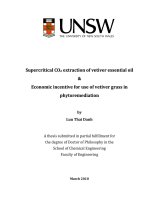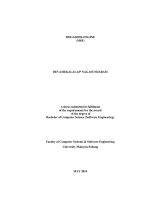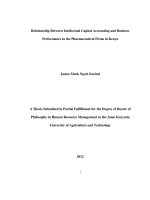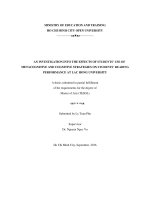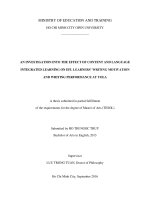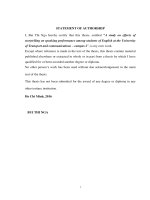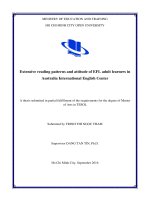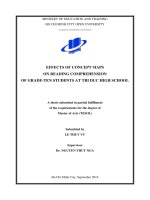A Thesis Submitted in Partial Fulfillment for the Degree of Doctor of Philosophy in Human Resource Management in the Jomo Kenyatta University of Agriculture and Technology
Bạn đang xem bản rút gọn của tài liệu. Xem và tải ngay bản đầy đủ của tài liệu tại đây (2.17 MB, 261 trang )
Relationship Between Intellectual Capital Accounting and Business
Performance in the Pharmaceutical Firms in Kenya
James Mark Ngari Karimi
A Thesis Submitted in Partial Fulfillment for the Degree of Doctor of
Philosophy in Human Resource Management in the Jomo Kenyatta
University of Agriculture and Technology
2012
i
DECLARATION
This thesis is my original work and has not been presented for a degree in any other
university
Signature:……………………………
Date:…………………………
James Mark Ngari Karimi
This thesis has been submitted for examination with our approval as University
Supervisors.
Signature: ……………………...
Date: ........................................
Dr. Robert Gichira
JKUAT, Kenya
Signature: ……………………...
Date: ........................................
Dr. Gichuhi A. Waititu
JKUAT, Kenya
ii
DEDICATION
This thesis is dedicated to first and foremost my parents Dad David and Mum Mary, my
wife Lenah and our lovely kids De‟john and Niquita whose love, strength, perseverance
and patience enabled me to overcome the many challenges and confrontations
throughout my doctoral studies.
iii
ACKNOWLEDGEMENT
I wish to express my gratitude to my supervisors Dr. Robert Gichira and Dr. Anthony
Waititu and the inspiration of Dr. Kabare Karanja whose guidance, support and time
input enabled me to carry out the study and write the thesis.
My sincere appreciation to my family; my lovely wife Lenah Ngari, son De‟john
Munene Ngari Jnr, daughter Niquita Wambui, Dad and Mum Mr. & Mrs David Karimi
and my collegues at Kenya Methodist University for their support in the research study.
Data analysis would have been a real nightmare had it not been for the instruction and
guidance from Dr. Gichuhi Anthony Waititu; I‟m sincerely indebted to him, Ombui
Monari and Alex Mwaniki who tirelessly worked on his SAS, AMOS and SPSS
software as I analyzed the data. Simon Machiri for his valuable input in formatting of
the final document, Catherine Kiragu was instrumental in her professional editorial work
while the PhD faculty members provided invaluable input to the study.
Am equally grateful to my doctoral colleagues among them Ben, Robert, Jane, and Mary
with whom we have had robust discussions in our peer group
iv
TABLE OF CONTENTS
DECLARATION ............................................................................................................... ii
DEDICATION .................................................................................................................. iii
ACKNOWLEDGEMENT ............................................................................................... iv
TABLE OF CONTENTS .................................................................................................. v
LIST OF TABLES .......................................................................................................... xii
LIST OF FIGURES ....................................................................................................... xiv
APPENDICES ................................................................................................................ xvi
ACRONYMS AND ABBREVIATIONS ..................................................................... xvii
DEFINITION OF OPERATIONAL TERMS .............................................................. xx
ABSTRACT .................................................................................................................. xxiv
CHAPTER ONE ............................................................................................................... 1
INTRODUCTION ............................................................................................................. 1
1.1 Background ................................................................................................................... 1
1.2 Statement of the Problem .............................................................................................. 8
1.3 General objective ........................................................................................................ 10
1.4 Hypothesis ................................................................................................................... 11
1.5 Importance of the study............................................................................................... 12
1.6 Scope of the study ..................................................................................................... 13
v
1.7 Limitations of the study .............................................................................................. 13
CHAPTER TWO ............................................................................................................ 15
LITERATURE REVIEW............................................................................................... 15
2.1 Introduction ................................................................................................................. 15
2.1.1 Knowledge Economy................................................................................... 15
2.1.2 Organizational Resources ............................................................................ 16
2.1.3 Physical Resources ...................................................................................... 16
2.1.4 Financial Resources ..................................................................................... 17
2.1.5 Human Resources ........................................................................................ 17
2.2 Theoretical and Conceptual Framework ..................................................................... 21
2.2.1 Human Capital Theory................................................................................. 24
2.2.2. Decision Usefulness Theory ....................................................................... 27
2.2.3 Agency theory .............................................................................................. 28
2.2.4. Stakeholder Theory ..................................................................................... 29
2.2.5. Legitimacy Theory ...................................................................................... 30
2.2.6. Resource Dependence and Resource Based Theories ................................ 31
2.2.7 Conceptual Framework ................................................................................ 43
2.2.8 Operationalization of variables .................................................................... 46
2.2.9 Human capital .............................................................................................. 46
2.2.10 Learning and Education ............................................................................. 47
vi
2.2.11 Experience and Expertise........................................................................... 47
2.2.12 Innovation and Creation............................................................................. 48
2.2.13 Structural Capital ....................................................................................... 49
2.2.14 Systems and programs ............................................................................... 49
2.2.15 Research and Development ....................................................................... 50
2.2.16 Intellectual Property Rights ....................................................................... 51
2.2.17 Relational Capital ...................................................................................... 53
2.2.18 Strategic Alliances, Licensing Agreement ................................................. 54
2.2.19 Relation with Partners, Suppliers and Customers ...................................... 55
2.2.20 Knowledge about Partners, Suppliers and Customer................................. 56
2.2.21 Business Performance ................................................................................ 57
2.2.22 Human Productivity ................................................................................... 59
2.2.23 Profitability ................................................................................................ 60
2.2.24 Market Valuation ....................................................................................... 60
2.3. Critique of the existing literature ............................................................................... 61
2.4 Summary ..................................................................................................................... 63
2.5 Research Gap .............................................................................................................. 66
CHAPTER THREE ........................................................................................................ 68
RESEARCH METHODOLOGY .................................................................................. 68
3.1 Introduction ................................................................................................................. 68
vii
3.2 Research Design .......................................................................................................... 72
3.2.1 Measurement of Dependent Variable .......................................................... 74
3.2.2 Measurement of Independent Variables ...................................................... 75
3.3 Population ................................................................................................................... 78
3.4 Sampling Frame .......................................................................................................... 78
3.5 Sample and sampling technique .................................................................................. 79
3.6 Instruments .................................................................................................................. 80
3.7 Data Collection Procedure .......................................................................................... 81
3.8 Pilot Test ..................................................................................................................... 83
3.9 Data Processing and Analysis ..................................................................................... 85
3.9.1 Linear multiple regression ........................................................................... 89
CHAPTER FOUR ........................................................................................................... 91
RESEARCH FINDINGS AND DISCUSSION ............................................................. 91
4.1 Introduction ................................................................................................................. 91
4.2 Response rate .............................................................................................................. 91
4.3 Reliability and validity analysis .................................................................................. 92
4.4 Factor Analysis of Independent and Dependent Variables ......................................... 94
4.4.1 Human Capital ............................................................................................. 96
4.4.2 Structural Capital ......................................................................................... 99
4.4.3 Relational Capital ...................................................................................... 102
viii
4.4.4 Business Performance ................................................................................ 104
4.5: Descriptive Statistics of Independent and Dependent Variables ............................. 108
4.5.1. Business Performance ............................................................................... 108
4.5.2 Human Capital ........................................................................................... 110
4.5.3 Structural Capital ....................................................................................... 113
4.5.4 Relational Capital ...................................................................................... 116
4.6. Inferential Statistics................................................................................................ 120
4.6.1. Normality of Business Performance ......................................................... 120
4.7 Influence of Human Capital and Business Performance........................................... 124
4.7.1 Scatter plot of Human Capital and Business Performance ........................ 125
4.7.2 Regression line fitting ................................................................................ 126
4.7.3 Objective 1: Goodness of fit ...................................................................... 128
4.7.4 Hypothesis 1: Human capital positively influences business performance of
pharmaceutical Firms in Kenya .......................................................................... 129
4.8 Influence of Structural Capital on Business Performance ........................................ 130
4.8.1 Scatter plot for Structural Capital and Business Performance ................... 131
4.8.2 Regression line fitting ................................................................................ 132
4.8.3 Objective 2: Goodness of fit ...................................................................... 134
4.9. Influence of Relational Capital on Business Performance ....................................... 137
4.9.1 Scatter plot for Relational Capital and Business Performance .................. 137
4.9.2 Regression line fitting ................................................................................ 138
ix
4.9.3 Objective 3: Goodness of fit ...................................................................... 140
4.9.4 Hypothesis 3: Relational capital positively influences Business
Performance of Pharmaceutical Firms in Kenya ................................................ 142
4.10 Hypothesis Results .................................................................................................. 143
4.11 Association among variables................................................................................... 144
4.12. Full Regression Model of Human Capital, Structural Capital and Relational
Capital with Business Performance ................................................................................ 150
4.13 Characteristics of collected data.............................................................................. 151
4.13.1 Checking for the normality of the residuals (errors)................................ 151
4.14. Model fitting .......................................................................................................... 154
4.14.1 Multiple Linear Regression Model .......................................................... 154
4.14.2. Multiple correlation coefficient .............................................................. 154
4.14.3. Significance of Individual Coefficients .................................................. 155
4.15. Data Transformation .............................................................................................. 157
4.15.1. Correlations for Logs of overall variables .............................................. 158
4.15.2 Linear Regression for Log Human Capital, Log Structural Capital, Log
Relational Capital and Log Business Performance............................................. 159
4.15.3 Significance of the overall Model ............................................................ 159
4.15.4 Regression of Log Human Capital, Log Structural Capital, Log Business
Performance ........................................................................................................ 161
CHAPTER FIVE ........................................................................................................... 165
SUMMARY, CONCLUSIONS AND RECOMMENDATIONS .............................. 165
x
5.1 Introduction ............................................................................................................... 165
5.2 Summary ................................................................................................................... 165
5.2.1 Key Objective 1 ......................................................................................... 167
5.2.2 Key Objective 2 ......................................................................................... 168
5.2.3 Key Objective 3 ......................................................................................... 169
5.3 Conclusions ............................................................................................................... 170
5.4 Recommendations ..................................................................................................... 173
5.4.1 Implications of the study to practice .......................................................... 176
5.4.2 Implications of the study to methodology ................................................. 178
5.4.3 Recommendations for further research ...................................................... 179
REFERENCES .............................................................................................................. 181
APPENDICES ............................................................................................................... 205
xi
LIST OF TABLES
Table 1
Comparison between the Positivist and Phenomenological Paradigms ......... 70
Table 2
Summary of Measures of Variables............................................................... 77
Table 3
Reliability and Validity measurement results ................................................ 93
Table 4
Rotated Component Matrix of Human Capital .............................................. 98
Table 5
Rotated Component Matrix of Structural Capital ........................................ 101
Table 6
Rotated Component Matrix of Relational Capital ....................................... 103
Table 7
Component matrix of Business Performance .............................................. 106
Table 8
Descriptive Statistics of Business Performance........................................... 108
Table 9
Descriptive statistics of Human Capital....................................................... 111
Table 10 Descriptive statistics of Structural Capital................................................... 114
Table 11 Descriptive statistics of Relational Capital .................................................. 117
Table 12 Checking for Normality of Business Performance ...................................... 121
Table 13 Correlations between Human Capital and Business Performance............... 126
Table 14 Regression Coefficients ............................................................................... 128
Table 15 Model Summary .......................................................................................... 129
Table 16 Coefficients of Human Capital against Business Performance ................... 130
Table 17 Correlation between Structural Capital and Business Performance ............ 132
Table 18 Regression coefficients ................................................................................ 134
Table 19 Model summary ........................................................................................... 135
xii
Table 20 Coefficients of structural capital against Business performance ................. 136
Table 21 Correlation between Relational Capital and business Performance ............ 138
Table 22 Regression Coefficients ............................................................................... 140
Table 23 Model Summary .......................................................................................... 141
Table 24 Regression Coefficients ............................................................................... 142
Table 25 Results of Hypothesis Testing ..................................................................... 144
Table 26 Correlations between Dependent and Independent Variables ..................... 145
Table 27 ANOVA ....................................................................................................... 150
Table 28 Overall model summary............................................................................... 154
Table 29 Regression coefficients ................................................................................ 156
Table 30 Correlations .................................................................................................. 158
Table 31 Model Summary .......................................................................................... 159
Table 32 ANOVA ....................................................................................................... 160
Table 33 Regression coefficients ................................................................................ 161
Table 34 Model Summary .......................................................................................... 162
Table 35 ANOVA ....................................................................................................... 162
Table 36 Regression Coefficients ............................................................................... 163
xiii
LIST OF FIGURES
Figure 1
Conceptual Framework ............................................................................ 45
Figure 2
Response rate ............................................................................................ 92
Figure 3
Scree Plot for Human Capital ................................................................... 96
Figure 4
Scree Plot for structural Capital ............................................................... 99
Figure 5
Scree Plot for Relational Capital ............................................................ 102
Figure 6
Scree plot of Business Performance ....................................................... 104
Figure 7
Box Plot for Human Capital ................................................................... 113
Figure 8
Box Plot of Structural Capital ................................................................ 116
Figure 9
Box Plot of Relational Capital ................................................................ 119
Figure 10
Normality of Business Performance ....................................................... 122
Figure 11
Normal quartile-quantile plot of business performance with theoretical
quantile line ............................................................................................ 123
Figure 12
Scatter Plot of Human Capital and Business Performance .................... 125
Figure 13
Significance of the fitted regression line ................................................ 127
Figure 14
Scatter Plot for Structural Capital and Business Performance ............... 131
Figure 15
Significance of fitted regression line ...................................................... 133
Figure 16
Scatter Plot of Relational Capital versus Business Performance ........... 137
Figure 17
Significance of the fitted regression lineFor the regression to be
significant, the following alternative hypothesis had to be true: ............ 139
xiv
Figure 18
Histogram for Business Performance Responses ................................... 152
Figure 19
Normal probability plot of regression standardized residue for Business
Performance ............................................................................................ 152
Figure 20
Scatter Plot of residue errors of Business Performance ......................... 153
xv
APPENDICES
Appendix 1
Questionnaire……………………………………...………….
Appendix 2
Pharmaceutical Firms in Kenya under the Pharmacy and
204
Poisons Board 2010-2011 …………………………………….. 218
Appendix 3
Factor analysis extraction of variables……………………........ 219
Appendix 4
Confirmatory factor analysis for independent and dependent
variables and the overall model………………………………
xvi
229
ACRONYMS AND ABBREVIATIONS
ATO
Assets Turn Over
AMOS
Analysis of Moment Structures
ANOVA
Analysis of Variance
BP
Business Performance
CEE
Capital Employed Efficiency
CFI
Comparative Fit Index
CK
Customer Knowledge
CSR
Customer and Supplier Relations
COMESA
Common Market for Eastern and Southern Africa
EE
Experience and Expertise
EP
Employee Productivity
EVA
Economic Value Added
EBIT
Earning Before Interest and Tax
GFI
Goodness of Fit Index
HCE
Human Capital Efficiency
HC
Human Capital
HR
Human Resources
ICE
Intellectual Capital Efficiency
xvii
IC
Intellectual Capital
IC
Innovation and Creation
ICA
Intellectual Capital Accounting
IPR
Intellectual Property Rights
LE
Learning and Education
MB
Market to Book Value Ratio
OECD
Organization for Economic Cooperation and Development
PC
Physical Capacity
PG
Profit Growth
PSK
Pharmaceutical Society of Kenya
Quantile Quantile
RC
Relational Capital
RD
Research and Development
RMR
Root Mean Residuals
RMSEA
Root Mean square error of approximation
ROA
Return On Assets
ROCE
Return on Capital Employed
SALA
Strategic Alliances, Licensing and Agreements
SAS
Statistical Analysis System
SC
Structural Capital
xviii
SF
Size of the firm
SG
Sales Growth
SP
Systems and Programs
SPSS
Statistical Package for Social Science
SV
Stock Value
xix
DEFINITION OF OPERATIONAL TERMS
Human capital- This is a range of valuable skills and knowledge a person has
accumulated overtime. Investment in education skills of the human resources (Edvinson
& Malone 1997, Bontis, 1998, Saint-Onge, 1996,)
Structural capital- Structural capital comprises all kinds of knowledge deposits such as
organizational routines, strategies, process handbooks, and databases (Boisot, 2002;
Ordonez de pablos 2004; Walsh & Ungson, 1991, Roos et al., 1998).
Relational capital- This is the ability of an organization to interact positively with
business community members to motivate the potential for wealth creation by enhancing
human and structural capital (Marti, 2001, Dewhurst & Navarro, 2004, Sveiby, 2000).
Relational capital comprises the knowledge embedded in all the relationships an
organization develops. Whether it is with customers, competitors, suppliers, trade
associations or government bodies (Bontis, et al., 2000).
Intellectual capital- According to Edvision & Malone, (1997), Intellectual Capital is
knowledge that can be converted into value. Stewart (1997) broadened the definition to
intellectual capital as intellectual material, knowledge, information, intellectual property,
experience that can be put to use to create wealth by developing competitive advantage
in an organization.
xx
Intellectual Capital Accounting- This is a process of identifying, measuring,
communicating economic information and reporting the range of human and knowledge
based factors that create sustained economic value in a business enterprise (Fincham, R.
& Roslender, R. 2003).
Intangible assets- IAS 38 Defines intangibles as separately identifiable, non monetary,
without physical substance Cearns (1999). One intangible Asset is human capital related.
For example trained and assembled workforce. This category should be considered as an
Asset (Tollington, 1997). This will provide a future economic benefit to the
organization. Intangible Asset may commence its life as an intellectual asset. For
example, the case of laboratory notes which will be a patent when the notes are
guidelines to manufacture medicine.
Business performance- This is achieved when an organization is generating the
maximum level of profitability possible given the human, financial, capital, and other
resources it possesses. Business performance is defined as measurable result of the level
of attainment of organizational goals or measurable result of the organizations
management of its aspects (Daft & Marcic, 2001), or mechanism for improving the
likelihood of the organization successfully implementing a strategy. Business
performance evaluation is the process to help management‟s decisions regarding an
organizations performance by selecting indicators, collecting and analyzing data,
xxi
assessing information against performance criteria, reporting and communicating and
periodically reviewing and improving this process.
Human productivity- Describes how efficiently inputs are converted into outputs.
According to (Patton, 2007), the productivity of a firm lies more on its intellectual
capital and system capabilities than on its hard assets. (Bontis et al., 2000) argues that
leveraging knowledge assets is the key to a firm‟s prosperity. A firm with higher capital
performance is expected to have higher rate of profitability and also it may experience
higher productivity (Rob, 2010, Saari, 2006, Lazear, 2000)
Profitability – This can be defined as the state or condition of yielding a financial profit
or gain. It is often measured by price to earnings ratio Business Dictionary, (2011).
Profitability shows the degree to which a firm‟s revenue exceeds over the costs.
Profitability was measured using sales growth which is the increase in sales over a
specific period of time, often but not necessarily annually and profit growth which is a
combination of profitability and growth, more precisely the combination of economic
profitability ( Brealey et al., 2005 Richard, 2011, Helfert, 1997, Harrington, 1993,
Fridson & Fernado, 2002).
Relationship – This is a correspondence between two variables that is Dependent
Variable versus Independent Variable (Mugenda, 2008, Sekaran, 2008).
xxii
Pharmaceutical firms – These are firms that develop produces and markets drugs
licensed for use as medication (Pharmaceutical society of Kenya, 2009).
Market valuation- This describes the degree to which a firm‟s market value exceeds its
book value. It is the ratio of the total market capitalization which is the average share
price time‟s number of outstanding common shares to book value of net assets hence
Human capital adds Shareholder Value (Watson, 2002),
xxiii
ABSTRACT
From the human resource point of view, intellectual capital is an investment in the
organization and it is perceived to be the strategic resource and a source of competitive
advantage and therefore not indicated on the statement of the financial position of a firm.
Intellectual capital in conventional accounting is indicated as a cost rather than an
investment. The purpose of the study was to test the relationship between intellectual
capital accounting and business performance of the pharmaceutical firms in Kenya and
why these firms do not account for human resources as competitive and strategic assets
which offer firms a competitive advantage.
The specific objectives were to determine whether human capital, structural capital and
relational capital individually and collectively influence business performance of
pharmaceutical firms in Kenya.
The study was carried out in Nairobi since most of the pharmaceutical firms were
located here apart from a few, which were based outside Nairobi. At present, the existing
research on intellectual capital accounting is concentrated on developed countries and
the policies and frameworks are derived from them as they are only suitable to
developed countries. However, none of these studies identify the relationship between
intellectual capital accounting and business performance in pharmaceutical firms in
Kenya and therefore the need to carry out the research.
xxiv
The research study adapted three research designs namely: Quantitative, explanatory and
descriptive research design. The target population constituted 89 pharmaceutical firms
and the sample frame was comprised of 31 local pharmaceutical firms licensed by
pharmacy and poisons board in 2010-2011 which formed the sample size, thus
represented 35% of the total population. Purposive sampling procedure was used to
arrive at 31 pharmaceutical firms while judgemental sampling was used to target the
human resource managers.
The instrument of data collection was a structured questionnaire with questions anchored
on a five (5) point likert type ranking scale which was administered to the respondents.
The data processing and analysis was done mainly by the use of logarithmic multiple
linear regression analysis. The researcher also employed inferential statistics to test the
hypothesis of the study.
The results and findings of the study indicated that human capital, structural capital and
relational capital influenced business performance of pharmaceutical firms in Kenya.
Human capital and structural capital relationship strongly existed among the studied
pharmaceutical firms; and that the two positively and significantly influenced business
performance. In addition to confirming that human capital, structural capital and
relational capital are dimensions of intellectual capital accounting, relational capital did
not interact with human capital and business performance but univariately it did.
xxv

